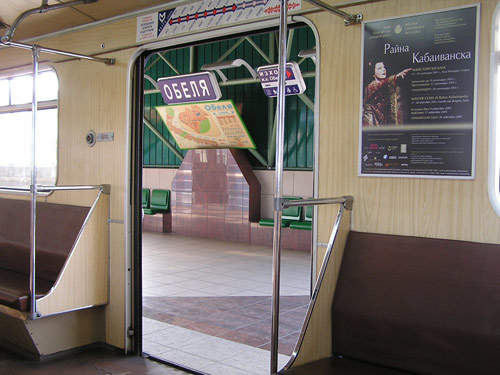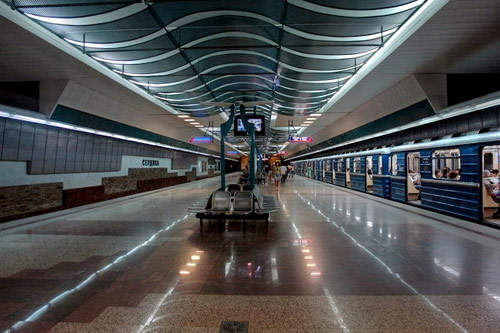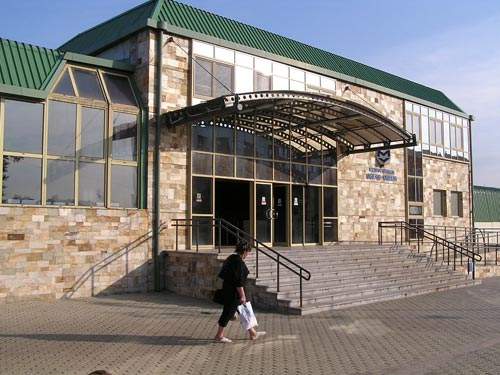Sofia Metro is an underground railway network in Sofia, capital of Bulgaria. The metro system will include three lines and will connect different regions of the city. Bulgarian Metropolitan-Sofia JSC is the operator of the entire metro system.
Sofia is the capital and largest city of Bulgaria and the 12th-highest populated city, with 1.4 million occupants, in Europe. The increased population of Sofia forced the construction of the metro system.
The project was planned in the 1960s and was executed for the first time in 1990s. It was planned to provide quick and safe transport to commuters.
The execution of the project was delayed as Sofia did not require an immediate underground system. The historical layers underneath Sofia’s core are also a cause for the delay.
The project
The metro system incorporates three lines with branches in the periphery. The 65km three lines connect 63 stations of Sofia.
The metro system’s operations on Line 1 started in January 1998. The system is currently operating a section of Line 1 with 14 stations.
The design features and technical parameters of the subway are as per the economic feasibility report of Bulgaria. The technical parameters of the system included under the economic feasibility report are minimum allowable interval between the chambers 90 sec, gauge of 1,435mm and power rolling stock with a nominal DC voltage of 825V through a contact rail.
In addition, the average distance between stations should be 1,100m, and the operating speed of rolling stock should be maintained at a maximum of 90km/h while the maximum carriage capacity per hour in a direction should be 50,000 commuters.
The European Investment Bank has invested about €105m to co-finance the construction of Line 1 extensions and the first section of the second metro line, and for the acquisition of an additional 15 trainsets.
Sofia Metro will carry about 1.2 million passengers daily. The approximate cost of the project is Є300m. The construction of the metro system was initially started in areas with peak traffic and the largest streams of passengers.
The first 6.5km section of Line 1 and five subway stations started its operations on 28 January 1998, from Slivnitsa to Konstantin Velichkov, while the second section of Line 1 connecting Konstantin Velichkov and Opalchenska has been in operation since 17 September 1999. Two other sections of Line 1 connecting Serdika to Opalchenska and Slivnitsa to Obelya were started on 31 October 2000 and 20 April 2003.
The section of Line 1 connecting Serdika and Vasil Levski was funded about €90m by the Bulgarian government through a long-term loan from Japan. The section included the construction of an intermediate station, St Kliment Ohridski.
The construction of the metro from Vasil Levski stadium to Serdika was started in 2005 while its operations began on 8 September 2009. Line 1 is 18km and connects 14 stations of Sofia. In May 2009, the section connecting Vasil Levski Stadium to Mladost I was opened to traffic. The 5.6km section has three intermediate stations.
Infrastructure
The entire metro will consist of three lines 29km, 17km and 19km long. The first line serves 23 stations, while the second and third will serve 17 and 23 stations respectively. All three lines intersect triangularly at the city centre.
The first of the three lines operates from Obelya to Mladost 1 of Sofia. Line 1 is being operated in two separate sections: Obelya to Serdika and Mladost 1 to Vasil Levski.
The metro trains that depart at Obelya move towards Mladost 1 through Zapaden Park via Slivnitsa and Lyulin. This south-east-bound line also connects Opalchenska and Konstantin Velichkov stations via Vardar station. The line linking Mladost 1 to Vasil Levski Stadium will connect Joliot-Curie, G.M.Dimitrov and Musagenitsa stations.
The sections Obelya to Serdika and Mladost 1 to Vasil Levski will be connected by a 2km link between Serdika and Vasil Levski National Stadium. Line 1 will be extended to the Druzhba estate and Sofia Airport.
The second line will connect Lozenets with Ilientsi via the city centre. A spur will connect the Line 1 terminus at Obelya to Line 2. The third line will connect the residential district of Kniazhevo to other residential districts Poduene and Vassil Levski.
Line 2 is designed to be an underground line for 10km and connects five stations. The tunnels of the metro were constructed during the 1980s, while Line 2 is scheduled to be launched in 2012.
The construction of a section of Line 2 connecting Nadezhda and Cherni Vrah Boulevard via Tsentralna station was started in December 2008 and scheduled to be open on 1 September 2012. The second phase includes extension of line from Nadezhda in the direction of north-west towards Obelya.
The construction of Line 2 stations National Palace of Culture (NDK) and Museum of the Earth and People (HEMUS) has been completed.
The structure of Sofia Metro station Serdika is a combination of unearthed Thracian and Roman ruins and modern architecture as the city contains historical layers. In 1982, two metro stations and the tunnels connecting them were built during the construction of the National Palace of Culture.
Rolling stock
The rolling stock of Sofia Metro includes 18 trams. These were upgraded by Inekon, under a €13.6m contract made with Sofia Metro.
The first vehicle was rebuilt as a prototype in the Czech Republic, while the remaining 17 were undertaken by Tramcar Sofia.
Contractors
Metropolitenat, owned by the Metropolitan Municipality serves the Sofia Metro and aims to provide safe and quick transport for commuters. The investment control of design, construction, operation and maintenance of existing sections of the metro are carried out by Metropolitenat.
The design and construction of Line 1 are being carried out by Bulgarian companies. Companies including Siemens, Ericsson, Elin, Alcatel and Otis are providing the management systems and basic equipment required for the metro system.
Russia is producing the wagons required for the metro system while the automation related to the equipment of wagons is being carried out by Bulgarian companies.
In May 2008, SYSTRA and two Bulgarian firms Infra Project and Metro Consult were awarded a contact to supervise the construction of Sofia Metro.
The future
Sofia Metro’s Line 1 will be extended towards the south-east from Mladost 1 in future years. It will be extended towards the south and a branch leading towards the airport will also be added. The construction of the first section of the branch was started in February 2009, while the construction work to extend the branch to the airport will begin in 2010 and is expected to be complete by 2020.
A €94m extension project connecting Mladost 1 to the International Exhibition Center, on Tsarigradsko Shose, was started on 2 July 2009 and is expected to be complete by 2012. It involves construction of 2.5km of tunnel, a station and a car parking area.










